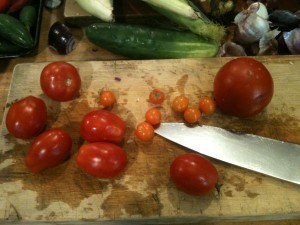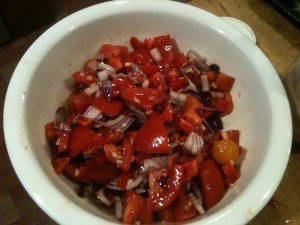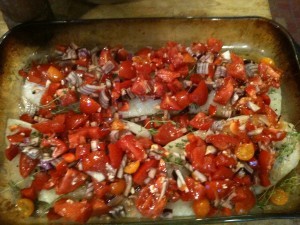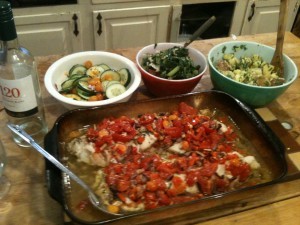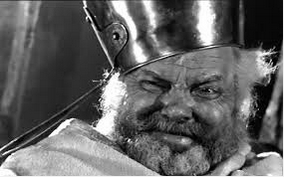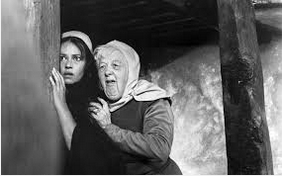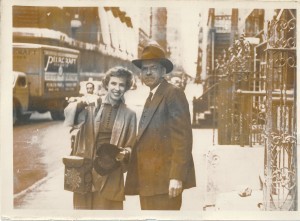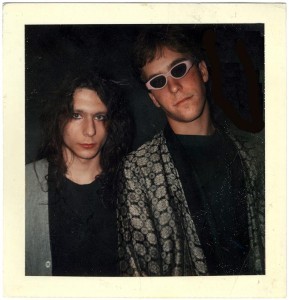Jon Frankel's Blog, page 14
September 12, 2016
A Dinner in Pictures
One of my favorites: fish baked with tomatoes, garlic, thyme and white wine. Cod is the fish, and I added diced red pepper and onion because at this time of year they are local, cheap and abundant. This is a bit of Provence in upstate NY. Also, parsley potatoes to soak up the gravy, sauteed chard from the garden, and a light salad of cucumbers, yellow pepper and red onion. This took one hour, from start to finish. The fish baked in the oven for 25 minutes. The potatoes took 15 minutes, the chard 8 minutes, and the salad no time at all.
September 1, 2016
CHIMES AT MIDNIGHT
Loving Orson Welles is a is a compulsion. He is singular, like Bob Dylan, and a wreck, like Marlon Brando. Unlike Brando he didn’t turn against his vocation, or his medium. Orson Welles was an actor in love with acting. He created great works for the stage, radio and in film. It is in film that he did his greatest work, and, famously, where he was mauled by the system. Few artists of his genius have been punished so relentlessly, but then, few arts require the financing that film does. Welles wasted the money guys’ cash, and paid for it. After the debacle of Ambersons he managed to make some good, even great movies, but most, except for A Touch of Evil, are flawed. And Touch of Evil was itself hurt by studio interference, and it was only Walter Murch’s restoration that put it solidly where it belonged. His Othello is brilliant but marred by bad sound and a chaotic production over years and countries. Chimes at Midnight suffers from the same problems, but it is a fully realized piece of cinematic art that is unlike anything else, deeply moving, gorgeously photographed and brilliantly acted. Welles’ was a Shakespearean his entire life. He famously staged a Voodoo Macbeth as a young man, as well as Julius Caesar and constructed out of Shakespeare’s history plays an epic called 5 Kings. Over the decades he refined his idea of staging the two quartets, funneling the story down to the relationship between his favorite character, Falstaff, and Prince Hal, golden but wayward son of the tragic usurper, Henry 4. Chimes telescopes the story, seeming to retain all of Falstaff’s scenes and dialog from the two Henry 4 plays. It is still about the coming of age of Henry the 5th.
Welles’ film is a film in every way, there is nothing left of the stage. But the performances and the intense drama he achieves are totally of the theatre. He is an alchemist. Filmed on location in Spain in a medieval village, it is deliriously bawdy, profane, the dialog thick with Shakespeare’s most famous insults, constructed of an elaborate invective, composed of scatological, sexual and barnyard humor. There s ceaseless action and a restless camera. The famous battle scene, lasting 6 minutes but taking weeks to film, is shot the way modern action sequences are but without the aide of computers, cgi and an army of assistants. The battle is frightening, made up of rapid cuts and hand held camera shots, slow motion, horses men and weapons in a montage of slaughter that is occasionally punctuated with shots of Falstaff, in armor, wandering around the periphery, flailing with his sword at nothing. The rapidity of the editing is totally contemporary. This is how action scenes are filmed today, but not in 1966. There is absolutely nothing dated about this movie. In single moments Welles’ camera spans the absurd and the tragic, the horrific mindless murder of war with the perpetual human instinct for folly and empty show. And his love is with Falstaff always, the fat, dissolute liar. Falstaff is a mountain of language, as grotesque explosion of wit and bullshit.
Shakespeare brings out the best in his interpreters, but in this film Welles’ shows that he was the equal of any in the 20th century. Chimes at Midnight is out in a restored Blue ray version as of August 30th, 2016. Buy it. If it comes to the big screen where you live, make the time to see it.
August 25, 2016
Dal
Trying to eat simply is a good idea, but time is of the essence. How much time will I spend on cooking? The slow food movement, which I endorse, despite the fact that it is a movement, prizes long process. But on a weeknight, after work, it can be challenging. Red lentils are an easy solution. They take 20 minutes to cook. I realize for many or most families this recipe will be a slow food recipe, because it takes about an hour to get it to table. And I have kitchen skills, which means I don’t have to think about things like, how to organize the prep. I also don’t work from a recipe. But having a vegetarian and nourishing meal on the table in an hour is worth it. And if this seems daunting for a Wednesday, then make it on Sunday.
I have been running all week with errands. Yesterday was no exception. I left work early to walk down to the mechanic’s to pick up my wreck of a car. I got home and it was hot. I had in my mind an insanely healthy sounding meal, dal with vegetables and black quinoa. I had no plan other than that. Both red lentils and quinoa have to be rinsed thoroughly, which is tedious. So I rinsed the red lentils and got them on the stove, and then rinsed the quinoa. Quinoa tastes bitter dirt if it isn’t rinsed in 4 or 5 or even 10 changes of water. The grains are tiny and hard. When rinsed properly quinoa tastes earthy, not like dirt. It’s still an acquired taste I suppose, but since it’s a taste I’ve acquired, it’s something I make more and more often. There are political economic considerations: it’s expensive, and the Bolivians for whom it is a staple increasingly are unable to afford it. But two cups goes a long way, and it’s gluten free and extremely healthy. So I cook it occasionally. I put the quinoa in a pot and add water, swirling and rubbing the grains between my fingers, and then pouring out the water through a strainer, because those little grains get away. Do this many times, until the water is clear. I’d say 6-10 times. The same method works with red lentils. Swish and pour, rinse and swish and pour, until the water is clear. So now the dal is on the stove and the quinoa is on the stove and all that remains is to prepare the spice mixture, the vegetables, and the fried onions.
My methods are riffs off of traditional Indian preparations. So: I cook the dal in water with a bay leaf and a cinnamon stick. I fry minced ginger with coriander, cumin and tumeric in oil for two minutes and put it into the pot. I add long cooking vegetables like kale and potatoes and carrots, chopped garlic and fresh onion cut into wedges. The I thinly slice onions and garlic and fry them in oil in which panch pora, or a mix of seeds, have been tempered. The mix is: fennel, fenugreek, cumin, black cumin and black mustard. Then I add the fast cooking vegetables, chard, green beans or zucchini, add the fried onion mixture, finish it with chopped tomatoes, cilantro, garam masala and lemon juice.
This sounds like an enormous amount of work, but it’s not, if you have these things on hand. As the the dal cooked with the potatoes and kale I ran out into the garden and picked some green beans, chard, tomatoes and carrots. As I chopped each thing I added it to the pot. It was easy because I have been making this dish or a variation on it for 30 years, and because I didn’t need to shop or look for things. My point here is not to say hey, I’m great! It is, rather, good nourishing food starts with a good pantry and developing a few techniques for getting it done.
So here is the recipe:
Quinoa
2 cups quinoa, rinsed thoroughly
4 cups water
1 t salt
Bring quinoa, water and salt to a boil, reduce heat, cook with the lid off until the grains have started to puff and then put a lid on it, lower the flame and let it absorb the water, for at least 20 minutes. Turn off the heat, fluff up the grains with a fork, and leave the lid on until you are ready to eat. If there is still water drain it out.
Dal
2 cups red lentils
8 cups water
2 t salt
1 bay leaf
1 cinnamon stick
Rinse dal thoroughly, until the water runs clear, and then combine all the ingredients in a pot. Bring to a boil and the reduce heat to a strong simmer.
Spice Mix
2-3 T minced ginger
2 T oil
4 t coriander
1 T cumin
1 t tumeric
1/2 t black pepper
Heat oil and add ginger. After a minute add the spices. Fry mixture over medium to low heat, stirring so it doesn’t burn until fragrant. Add to the dal, adding water from the dal back into the frying pan to get all of the spice mixture.
Vegetables
This is up to the chef. Any combination will do. The longer they cook the softer they’ll be. Indian cooking prizes soft vegetables. I used a handful of diced potatoes, two handfuls of chopped kale, a handful of carrots chopped into chunks, 4 cloves of garlic, a handful of wedged onions. Then I added a handful of beans and 4 stalks of swiss chard. This is when you can add as many jalapeno peppers as you like.
Fried Onions
One large onion thinly sliced (if it’s a giant onion, make it half)
4 cloves garlic, sliced
1/2 t each whole cumin, black mustard seeds, fennel seeds, fenugreek and black cumin if you have it. I also used a tiny bit of asfoeteda.
4 T oil
Heat oil in an iron frying pan over medium heat. Add seeds. When they begin to pop, add onions and garlic, stir, raise heat to medium high and fry, stirring often, until browned. Add to the dal.
The Finish Line:
2 C quartered plum tomatoes, or round tomatoes cut into eighths
1/2 C chopped cilantro
Juice of two lemons
1 t garam masala
When the vegetables are tender, and the fried onion mixture is done and in the pot, add a teaspoon of garam masala and the tomatoes. Stir. When the tomatoes are heated up (a minute or two) add the lemon juice and cilantro. Taste for salt. Serve with the quinoa. You will be happy. I was.
SERVES 6
August 24, 2016
IT WILL BE CORN
I haven’t written anything here in a long time. I have no idea how that happened, maybe nothing to say? It is a long standing principle of mine that as a writer I should only write when I have something to say. Yet I have cooked many meals since the last post! So I want to write about food briefly, and this being summer, it will be corn. The drought here in the Finger Lakes has been awful. It follows a warm spring with a late frost. That late frost saw temperatures of 5 degrees, which killed the cherry buds and killed my peach tree outright. The drought then did in the raspberries. Anything that didn’t get water either died or retreated deep into itself. That said, there are great tomatoes and peppers this year, excellent onions, garlic and corn. Last night I had a big bowl of leftover bean thread noodles, and some corn. I decided to make a Chinese corn dish. I love fried corn. You cut the kernels off the cob and then cook them in any number of ways: with bacon or sausage for instance. For this dish I briefly stir fried corn with jalapenos, garlic, sweet pepper and onions.
Stir Fried Corn
4 ears of corn
1 large jalapeno pepper, chopped into small dice (with or without seeds, I like seeds and heat)
4 cloves of garlic, chopped
1/4 cup green or red sweet pepper, diced
1/4 cup red onion, diced
two pinches of salt
2T vegetable oil, (not olive oil)
2 t sesame oil
2 T vinegar ( I used Chenkong, but you can use any vinegar)
Cut kernels off the cob. Get a wok very hot, add 2 T of oil. Add garlic and jalapenos, stir fry until fragrant, then add the corn and 1 pinch of salt. Stir fry for a minute or two, then add the onion and sweet pepper. Stir fry briefly, add the second pinch of salt, sesame oil and vinegar. Let it sizzle and serve. You can eat this with rice, but I loved it with the bean threads. Bean threads are easy. You soak them in hot water until soft. They come in bundles, and they are quite long, so you have to cut through them 2-3 times with two sharp knives, after they are soaked and drained, and in a bowl. It’s a scissors like motion.
April 19, 2016
TEACH, NOT PREACH
I have been resisting the urge to write about this election for weeks now. It is a delicious situation, with so much to write about, but the increasingly demented rhetoric on the Democratic side has made me want to remain silent. What I have to say can only incite more demented rhetoric, and yet, I feel like I have to speak up. So this is it: I am supporting Bernie, am voting for him in the primary and would happily vote for him for president. But I don’t believe he will be the nominee and will happily vote for Clinton in the fall. A few things: I don’t like Hillary Clinton, and I do like Bernie Sanders. But I’m not sure Bernie would be the better president. This is the crux: we are in an election year the Republicans should win, but because they are, well, the Republicans, they will likely lose. The idea that Bernie is the stronger candidate in the fall has not at all been demonstrated. The polls that show him ahead aren’t accurate. You would have to have very granular polling of a few key swing states, and good polling in all 50, to really say that Bernie is the stronger general election candidate. If Trump or Cruz are the nominees it’s possible, but what if they pull out a Rubio or Kasich? Not likely, but consider that. Also, my guts tell me after 55 years of life in America that somehow the establishment will make sure there is never a Democratic Socialist president. I don’t know how they’ll do it, but I’m confident they’ll find a way, even if it means a Republican makes it.
I am voting for Sanders because I agree with him on the issues, and I love his persona, or rather, I love who he is. This is emotional. I grew up with guys like Bernie. And they have been carrying the torch for economic democracy through the long horrid decades of the Nixon/Reagan/Bush reaction. Bernie is better than ANY Republican. And the Republican Party and platform will dominate even a reasonable, decent man like Kasich, who, by the way, is to the right of Reagan and Nixon. Compassionate Conservativism is Katrina and Flint. Sanders is not just a protest candidate. I know, I’ve voted for them all, and none have gotten the kinds of numbers he has. It’s exciting to vote for a candidate who says things no major party candidate has said since Robert Kennedy ran.
I have to publicly disagree with my dear old friend Al Giordano, whose latest tirade against Sanders really goes over the line. In his latest newsletter on the NY primary (find Al on TSU) he says Sanders’ appeal to class conceals a “dangerous undertow of white supremacy.” Al, this is over the line. You know damn well that Bernie Sanders is not a white supremacist, and that his economic populism is not rooted in the 19th century but in socialist/left/progressivism that ultimately has roots in Marx. The Communist Party in America was the earliest and strongest supporter of civil rights on the American political scene. And Bernie’s economic message goes absolutely to the heart of institutional racism. The South Bronx and neighborhoods like it would benefit more from his policies than Clinton’s. Universal health care, free college and infrastructure investment would improve the lives of people of color period. Without getting into the details, imagine the Bronx (in a major river delta) if we continue to deny climate change and refuse to finance infrastructure projects that will mitigate rising sea levels? The main critique here is, he’ll never get those bills through congress. Agreed. But Ronald Reagan won elections advocating policies he could never get through congress. To call Sanders and his supporters closet (or unconscious) white supremacists, and continually to caricature them as clueless white millennials is insulting and serves no purpose. I agree that the picture you present of Bernie supporters in the Bronx, particularly the vile sign The Bronx Is Berning, is ugly. But the fact is he enjoys widespread minority support among young people, and even with the bad press and familiarity of the Clintons in those communities, decent support among older voters. We both know Hillary is going to be the nominee, but we also both know that she can’t win without a high turnout, and that Sanders is the key to a high turnout. We need to encourage young voters to see this as a long struggle, and we need to fold them into the party, not drive them out with ad hominem attacks. Stereotypes are damaging because they aren’t true.
Bernie supporters, please, relax. When you lose it isn’t because the system is rigged against you. You lose because as great as Bernie is, this is still America. It might be that everyone you know supports him, it might be that he is full of passionate intensity, and it might be that he has won 7 or 8 states. But that’s not how it works. Obama didn’t win just because he got 30,000 people to show up at rallies, or because he was full of passion, he won because he had the better ground game and worked out the delegate math. Winning 7 states where 12 people live isn’t the same as winning 1 state with 20 million people. Bernie doesn’t deserve to win because he is right. No one ‘deserves’ to win. The one with the most votes wins, and that’s Clinton, just as it was Obama in 2008. Our best hope is to stick together. Hillary Clinton is not likeable, but she’s not the caricature that Republicans have carefully limned either. She is the consummate insider. There are rewards and risks with such politicians. But they can get things done. Lyndon Johnson and Franklin Roosevelt are examples of insider presidents who accomplished much. In Johnson’s case we all know the downside. No one voted for Nixon because they loved him, and I suspect few will vote for Hillary because they love her. But the Clintons, even if they seem to lack core values, have an excellent nose for the middle and what can be accomplished. If the pressure from the progressive wing of the party is sufficient, if the Sanders campaign can turn out voters not just in this election, but in the midterms and in local elections, then the party can be moved to the left, because progressives will have power. The Republicans have demonstrated the danger of the ideological echo chamber. America is not, fundamentally, and ideological nation, but a nation of coalitions. Every year we hear from Republicans that if they’d only run a more pure candidate, then they’d win. Democrats should beware of that path. We defeat them when we are united and when we vote. Hillary and Bernie represent powerful choices of the center and the left. We need each other to prevent a catastrophe. But it is not enough anymore to simply be like the child hiding an alcoholic father’s bottle of liquor. We have to change this country from the ground up, not just turn out every 4 years with feelings of idealism and entitlement, followed by disillusionment and apathy. Al Giordano has worked his entire life for this. I guess the Bronx really pissed him off. Al, you need to teach, not preach!
April 7, 2016
SPARROW
SPARROW
It’s not the wind that lacerates
Not the wind that barks or howls.
The wolf at the door is a sullen soul.
I hear the whispering wings of owls
And feel the game that macerates,
The long trackless night like a hole
In the sky that drains the day of light.
What was big within is put to flight.
Where have you gone little sparrow?
Without you, long is the way, and narrow.
March 17, 2016
ISABEL BOLTON: 3 NOVELS OF NEW YORK
NEW YORK MOSAIC
THREE NOVELS BY ISABEL BOLTON
DO I WAKE OR DO I SLEEP (1946)
THE CHRISTMAS TREE (1949)
MANY MANSION (1952)
Steerforth Press, South Royalton, Vermont, 1997
The three novels collected here were published between 1946 and 1952 to no acclaim at all. They sank into oblivion, recognized only by Diana Trilling, who compared the author to Henry James, and Edmund Wilson. Decades later Gore Vidal reviewed them, and suggested Wilson’s enthusiasm was at least in part stimulated by the gender of the author, whom he did not know was in her late sixties. Either way, they were at least recognized by two people whose work would remain available, so that Doris Grumbach, discovering them in 1978, could do the work that would bring them back into print 50 years after their first publication. Isabel Bolton is a pseudonym for Mary Britton Millar, about whom practically nothing is known. She was born 1883 and died in 1975. She lived in the Village, along with many other authors of her vintage. I came across Bolton in Steven Dillon’s Wolf-Women and Phantom Ladies: Female Desire in 1940s US Culture (Albany: State University of New York Press, 2015.). Millar wrote poetry, and a memoir of her childhood, which is supposed to be brilliant. She is quoted as saying that all fiction is autobiography, so I am guessing that the stories she tells in these three novels are close to life, if not memoir.
New York Mosaic is a beautiful book in which the city of New York shimmers. Page after page is filled with the incidental detail of life in the city, of its sounds, its moods and its odors and especially, the fragrance of its time. The similarity to James is the use of a consciousness through which all of the action is filtered, mixing memory and desire. But where James is suggestive and elusive, especially with sex, Bolton is explicit. There are naked people in these books, gay people, lovers, and orgasms, but no condemnation or judgment.
In Do I wake or Do I Sleep practically nothing happens at all. It is set shortly before World War 2. A charming, shallow socialite, Bridget, meets her friends Millicent (through whose eyes the story unfolds) and Percy for lunch. Cocktails follow, then a light dinner, and then a party. To give the bones of the plot is to betray the magic of this novel, for it is in the weaving of Millicent’s past and her observations of the people around her that the warmth and loveliness of the story lies. People get drunk at a long and tedious cocktail party. There is an act of violence. Millicent flies to the rescue of Percy, and Bridget falls in love for the 25th time. It sounds obnoxious but it is not. It is a glimpse at New York’s smoke filled martini parties, and of the apocalyptic feel of hypermodern architecture, as well as French restaurants, where they dine on Dover sole brought in by ship. The deepest note of unease, the dissonant bass note thrumming to the surface periodically, is Hitler, and the crisis caused by Bridget’s secret, that she has a daughter living in Austria, and that the father is Jewish.
The Christmas Tree is much more astonishing and melodramatic. The filter here is Hilly Danforth, older than Millicent by at least ten years, a grandmother caring for her 5 year old grandson, Henry. It is Christmas Eve in 1945. Henry’s mother Anne is returning to New York from Reno, where she has divorced Hilly’s son Larry and married a war hero, The Captain. Larry is gay, and explicitly so. Because of a series of telegrams, Larry is coming to New York too, and his boyfriend, whom he breaks up with, George, follows him. Larry, George, Anne and the Captain converge on Hilly’s apartment, and the expected narrative explosion occurs. But long before this Hilly has stripped back every layer of her life, and of the wealthy, nasty, duplicitous family she comes from. In this book the apocalyptic feel increases, as Henry plays with a B24 bomber, the one used on Hiroshima and Nagasaki. Bolton explores desire initially through the language of psychoanalysis, a fad at the time, but radiates far beyond it.
The last volume, Many Mansions, is set in 1950, and is narrated through the mind of an 84 year old woman. Again the past is plundered, and again by a woman solitary. Now she is old and she explores her loneliness, the fact that she has never married, and the consequences of a child she bore out of wedlock and who is taken from her by Victorian custom. She has written a novel, and she rereads this novel while preparing to meet a young man she knows to give him 50 dollars. Through the course of the novel her life funnels into an isolation she accepts but is disturbed by. There is a climax, again somewhat melodramatic, but to me, that makes no difference for again it is the texture of memory, of the city, and of the sense both writer and protagonist bring to the crises that have shaped her life.
What makes the books rise above their individual melodramas is the artistry, the presence of an overall design, which is perfectly and quietly done. The books are almost of equal length, 125 pages, and each presents a woman at a different age. By the end it takes on the aspect of a single life, narrated at three different points in time. There is no self-pity in these pages even where there is great loss and pain. If anything, pain is something she is curious about, something that must be solved, and this individual pain is always contextualized by the events of the time, especially of the 30’s and the war. Her emotional vocabulary and her ability to convey feeling as well as a style that allows the story to hover above the plot like mist above a lake is extraordinary. In this sense I think John Williams’ Stoner is the book that comes closest to it both in method and mood, which places it in rare company.
I loved these books, wildly.
March 10, 2016
BLUE ICE
A couple of weeks ago I was in Vermont for the funeral of an old friend, Cate Stratton. Cate’s brother Bob and I met at Oberlin, and we’ve been close ever since. He introduced me and Shelly to his family in 1983 when we were traveling in Australia and were headed to Asia. His parents, Bob and Carol, put us up for two months in Manila. We spent Thanksgiving, Christmas and New Years’ with them. And we got to know Bob’s sisters Susan and Cate. For about ten years after we were part of the incredible Stratton carnival of family and friends, a sprawl of good living, travel, intelligent conversation, great art, great food. Cate was always the leader, the jewel in the crown. When Cate arrived the party started, and sadly, it ended a few weeks ago for her. What came out of it for me was reconnecting to this family I’ve always loved and who shaped who I am as a person. I found there dozens of others like me, swept up in Bob and Carol’s generosity and grace over the years, and who loved Cate beyond description. They are strong people. To see sons who lost a mother, a brother and sister who lost a sibling, a mother and father who lost a daughter, and friends who lost a soul that filled out their own, was heartbreaking. To be included was amazing. I wrote a poem and posted it earlier, about the loss, and the loss lately of so many. But I wanted to write something more, and on the long, beautiful drive from Vermont to Ithaca, through the strange moods of rural devastation and beauty, I kept looking through the window at the frozen lakes, ponds, creeks and rivers. And I wrote this. Which I want to share with the Strattons, as the small thing I can do for the big thing they have done and continue to do.
Blue Ice
The frozen lake along the road is blue
Not the blue of sky or pilot lights
But of lichen inching on a rock and mildew
The drowned trees rising like knights
In opaque glass, their lances high
Limbs broken at the cleft. It flows
Into a river, plates of ice lie
Piled up as the jams break, crows
Cry overhead disrupted broken notes
Of panic as the shattered water floats
Off through sky in a minor key
The unmeasured music of catastrophe.
March 4, 2016
Kristian Hoffman
This link was posted by someone on facebook. It’s from a piece written in 2010 by Kristian Hoffman, who was in the Mumps, and played with James Chance, Lydia Lunch, and Klaus Nomi. He had a band called The Swinging Madisons. He wrote the song Belinda.
This is easily the best thing I’ve ever read about what a night was like in those years. He didn’t know me, but I knew him, and the Vodka sisters, and Bradlee Field and have been in all those places, and know that van, and the rehearsal space, and it’s dead-on.
February 29, 2016
Walk
Walk
Snarls and whips of bracken
An eye glowing behind a lid of cloud
And fractals of black branches
Dulled by wrinkled ice in a ditch
The frozen face of the wind





